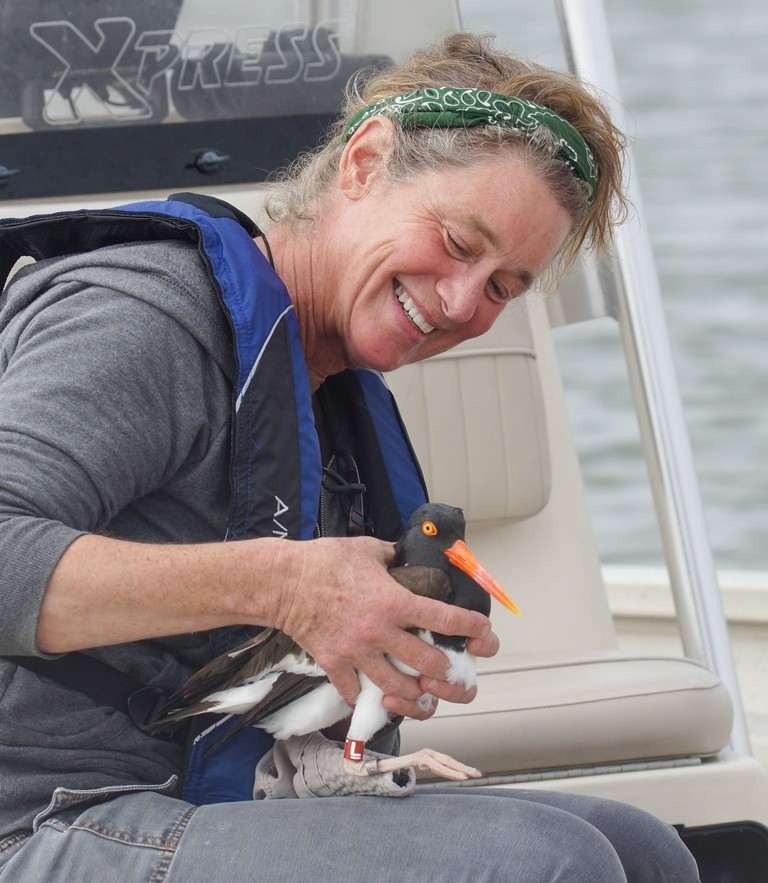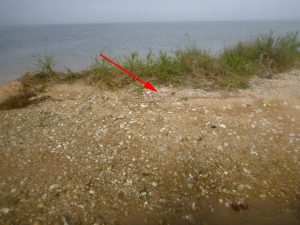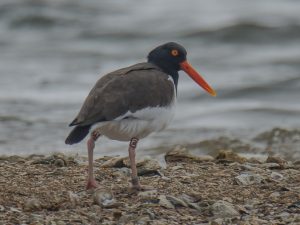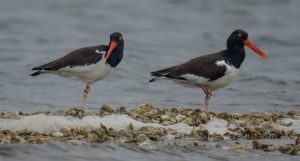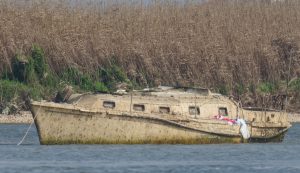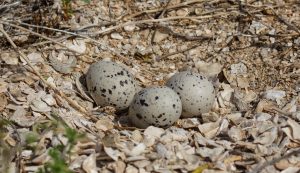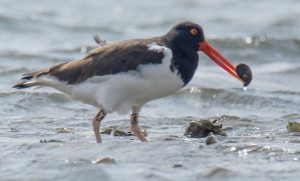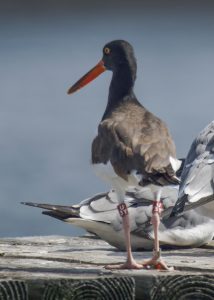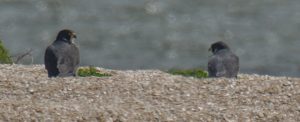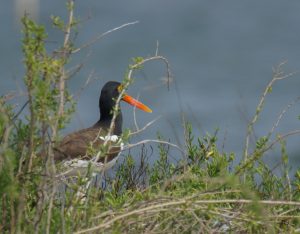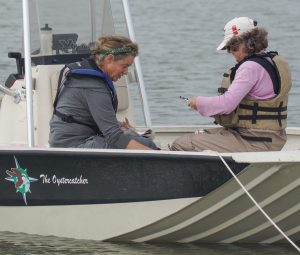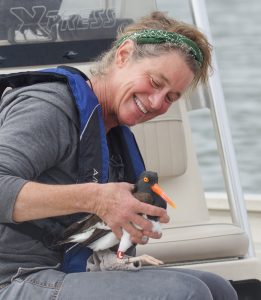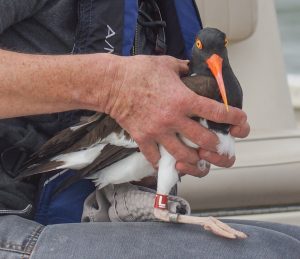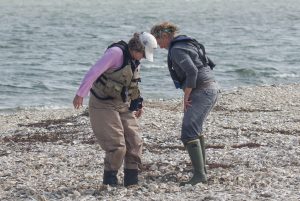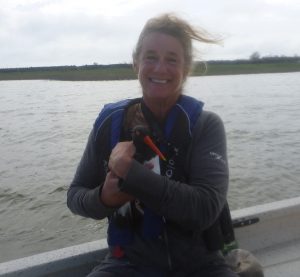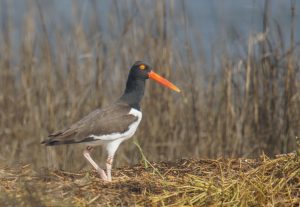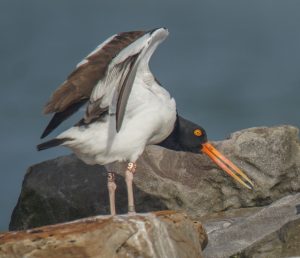By Susan Heath
Another exciting week of oystercatchering! I had planned to do West Galveston Bay on Wednesday and East Matagorda Bay on Friday but Manomet is doing an aerial survey for American Oystercatchers in the U.S. to get a population count and they wanted people to count birds from boats so they could ground truth the aerial survey. It’s hard to count birds from the air here in Texas because our birds don’t flock up into big groups like they do on the Atlantic Coast in winter. Plus our birds breed really early! So anyway, they were planning on flying the Galveston area on Thursday so we changed our plan from Wednesday to Thursday. Then the weather was bad on Thursday and we couldn’t go out in the boat. Ditto the plane so we moved to Friday and dropped East Matagorda Bay from the plan. It was foggy (again) but seemed to be clearing so we headed out from the boat ramp about 9:30 on Friday morning. Right off the bat we found that R3 & unbanded had a nest on one of the small islands near the boat ramp.
It is very low and I expect it will get overwashed but maybe they’ll be lucky. We followed Tiki Island around because it was still a bit foggy and checked all the islands in Jones Bay. We found FR (Fred) with an unbanded bird. What happened to Y2 his mate from last year?
Poor Fred has a pretty terrible nesting territory so I was thinking that Y2 moved on to find a male with a better territory. We didn’t find any other oystercatchers in Jones Bay so we headed over to West Galveston Bay. It was even foggier there which made all of us uncomfortable. We’ve got a GPS so we won’t get lost but you never know when some yahoo will come flying down the GIWW not paying attention. We hugged a line of reefs down toward Harbor Walk staying out of the main channel and found a few birds on the reefs there including….. you guessed it – Y2. She was with CA, another male that nests in Jones Bay so it appears she left Fred and moved in with CA. CA has a better territory than FR but not by much. It will be interesting to see how she does.
The fog still had not cleared when got down by Harbor Walk so we worked our way back up the GIWW slowly and then took a shallow but safe route along the side of Marker 52. My buddy H0 and his wife JC were loafing on their territory but not looking like they had anything going on. Ditto the rest of the oystercatchers in that area. Better get going guys! The early bird catches the worm so to speak. The fog finally cleared as we putted our way up the island which allowed us to see this.
That thing looks like it belongs in a scary movie if you ask me. It has certainly been abandoned for a while and it wasn’t there last week so it must be drifting around with the tides. It’s a Ghost Boat! Once we were done with that area, we headed over towards South Deer but checked a couple reefs on the way. We are still breaking the motor in on the new boat but those in the know said it would be good to open it up for a short period so when we were in the GIWW Robin pushed the throttle all the way. Wow! We were going faster than any of us were comfortable with. Of course it was bumpy due to wind so maybe on a calmer day, we will try that again. For now I’m happy keeping it at medium speed. The boat is really great though and I have to give a big shout out to one our volunteers Keith Wise for suggesting we get this type of boat and helping me buy it. I hadn’t heard of this brand before but it is super! It’s an Xpress SW20B shallow water bay boat.
There wasn’t much happening on South Deer though most of the pairs were guarding their territories. When we got to the final pair, KK & unbanded, they were nowhere to be seen and then suddenly there they were along the island’s edge. Hum. Sketchy behavior for sure. We checked it out and sure enough, they had a nest!
We checked out Confederate Reef and found Y7 having a meal. Kudos to whoever can figure out what kind of mussel or clam that is.
We found seven birds on the Sportsman Road reefs including little U3Y, T5 & T6’s chick from last year. Last week U3Y was with its parents on their nesting island which was a big surprise but perhaps it was just back for a visit last week because this week it was hanging with some other non-breeders including XA and XC.
Nothing happening at Gangs Bayou either but we saw two birds sitting on the island and we couldn’t figure out what they were because they were too far away so Alan took a photo. Here it is.
I didn’t think Peregrine Falcons were that friendly on the wintering grounds! Interesting. We headed back up the bay to check on the pair that nests on Galveston Island east of 8 Mile Road. We haven’t seen them in the area where they’ve nested before but this week they were hanging right there so I was suspicious they had a nest. I don’t like to approach their nests because there are a lot of mammals there and we could leave a scent trail to the nest. This is where our game cam picked up a cat taking an egg from a nest so I tried to look from afar. Sure enough I saw one through my binoculars so I retreated quickly and we headed out.
Nothing happening on the next island we checked either but all the pairs were there. We headed to the last island in part of the bay where we found three nests last week. These birds are really wise to our ways so it’s hard to see them incubating their nests as they sneak away when we get close. We looked from afar but still couldn’t really see any of them on their nests. I did see birds in the general area of each nest though so I figured all three nests were going strong. Here’s one looking like its sneaking away from a nest.
We found that L8 & L9 have a nest now too so that makes four on that island with only one pair there without a nest at this point. This island supports a lot of other nesting species but none of them are active yet so we used the box to trap one of the KR’s unbanded mate and it worked great! It only took 6 minutes for it to get trapped. We banded it LT.
Robin was pretty psyched to hold her first oystercatcher.
I don’t think LT was very happy with us though.
From there we headed up towards Swan Lake. At Zimmerman Point we found 20 with an unbanded bird. Alan said he had seen this pair on the beach a few days ago. What happened to 21? 20 & 21 have been paired since at least 2012 when we banded them so for 21 to disappear probably means sad news. At Malone we set up the noose carpets to see if we could trap one of that unbanded pair. Here’s Robin and I clearing a spot for the carpets. Alan said we were doing the oystercatcher dance!
They flew off to a nearby breakwater when we tried to spook them back to the decoys so we had to take the boat over and spook them off of there so they’d fly back which they did. Once they saw the decoys and heard the call they started doing their thing trying to chase away the intruders. Eventually one got a foot tangled and we banded it LR. We’ll try to get the other one in the box when they have a nest!
In Swan Lake we approached K7 & unbanded’s territory slowly but didn’t see them anywhere. Strange. They are pretty territorial. Then suddenly one was on the water’s edge and the other one was walking along the shell ridge.
Ding, ding, ding. My nest radar went off. We went to look and found a two egg nest. This pair is SO sneaky. If you followed last year, you might remember that they had two chicks and we were unable to find them to band them even after several attempts. Nothing else happening in Swan Lake but we got to see this.
A whole flock of Long-billed Curlews. Nice! We found L5 & 39 hanging out on the breakwater and 39 showed us a great oystercatcher stretch.
We are adopting out pairs of birds again this year as fund raiser for this project. We greatly appreciate all who have adopted pairs in the past! If you aren’t familiar with the program – you can adopt a pair of oystercatchers for a $100 donation and I will update you monthly on their progress throughout the breeding season. Most pairs are from West Galveston Bay, but there is a pair from Dickinson Bay and a pair from Swan Lake too. If you want a pair from East Matagorda Bay let me know.
Current Stats for upper Texas coast from Dickinson Bay to East Matagorda Bay: 8 nests being incubated, 0 failed nests, 0 nests with unfledged chicks, 0 nests with undetermined status, 0 chicks fledged
This project is supported by the National Fish and Wildlife Foundation and several private donors. If you would like to contribute you can call our office for information on how to do so (979-480-0999). All donations are tax deductible and GREATLY appreciated.
Note: All trapping and banding for this project is in accordance with federal and state permits issued to Susan Heath, GCBO Director of Conservation Research. Bird handling by volunteers is only permitted in the presence of Susan Heath and volunteers are trained in proper bird handling techniques.

